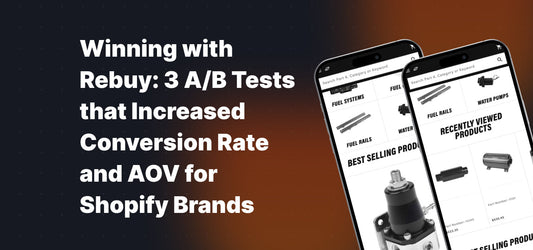Table of Contents
- The Newest and Most Recommended: Affinity
- 2 class="c16" style="text-align: left;"
- The Customisation Powerhouse: Novum
- 2 class="c16" style="text-align: left;"
- Balanced Flexibility: Prima
- 2 class="c16" style="text-align: left;"
- Which Recharge Theme Should You Choose?
- Next Steps for Recharge Customisation
Get useful eCommerce stuff
These days, having an intuitive, customisable, and optimised subscription management tool for mobile is essential. Recharge offers multiple customer portal themes, each catering to different needs and levels of customisation. Today, we’re looking at Affinity, Novum, and Prima. At Blend Commerce, we’ve worked extensively with each theme and understand which theme works best for specific client needs. In this article, we'll break down each theme's differences, advantages, and use cases to help you choose the best option for your store.
The Newest and Most Recommended: Affinity
Affinity is Recharge's latest theme. It is designed for a user-friendly, streamlined experience that excels on mobile devices. This theme provides a strong foundation for any subscription-based eCommerce site, especially for businesses looking for a best-practice structure without heavy customisation.

Key Points on Affinity:
- Mobile Optimisation: Affinity is fully optimised for mobile, catering to the growing trend of mobile-first consumers.
- Ease of Setup: Designed for easy deployment, with settings available in the customiser to adjust branding and styling.
- Limited Customisation: While branding elements are customisable, the structure remains consistent, similar to Shopify’s checkout system. This limitation ensures a stable, well-tested user experience, which is ideal for brands that don’t need a heavily customised portal.
| Pros for Affinity | Cons for Affinity |
| Optimised mobile experience, excellent for stores prioritising a seamless mobile checkout. | Limited structural customisation—brands needing a unique layout or functionality might find it restrictive |
| Straightforward setup, ideal for brands without a need for intricate portal customisations. | Best suited for brands with simple customisation needs due to limited customisation options outside of visual settings |
| Supports brand styling adjustments to stay on-brand. |

The Customisation Powerhouse: Novum
Novum is often the go-to theme for brands with unique requirements or specific design and functional needs. Designed with a mobile-first approach, Novum allows for a high degree of customisation, making it suitable for eCommerce stores that want to tailor the subscription experience to their audience in a detailed way.

Blend utilised Novum when building a powerhouse subscription offering for our client, Certainly Wood, that needed custom work to include a membership. They wanted to implement a solution that allowed customers to automate repeat purchases and offered a membership program that provided additional perks. The challenge was to do this in a way that aligned with the brand’s values and didn’t disrupt the user experience. Blend took on the challenge by implementing two key features for Certainly Wood: subscriptions and memberships. The process was highly detailed, ensuring that every aspect of the project was tailored to the brand’s needs.
Here’s what Sandra Taylor had to say about the experience:

Key Points for Novum:
- Mobile-First Design: While offering flexibility, Novum doesn’t compromise on the mobile experience.
- Highly Customisable: Through Recharge’s Theme Engine, developers can build a fully custom customer portal experience using Novum as a foundation.
| Pros for Novum | Cons for Novum |
| Built for mobile-first, ideal for custom, mobile-optimised experiences. | Requires development resources for customisation, which may add time and cost. |
| High flexibility with Theme Engine, enabling extensive customisations. | Not ideal for clients needing a simple, plug-and-play solution. |

Balanced Flexibility: Prima
Prima offers a balanced approach between Affinity’s streamlined setup and Novum’s customisation capabilities. While not specifically optimised for mobile like Novum, Prima is still a solid choice for businesses that may require moderate customisation without going fully custom.
Key Points for Prima:
- Moderate Customisation Potential: Prima allows for customisation in the Theme Engine, though not as extensive as Novum.
- Versatile Structure: Suitable for brands that need more than Affinity’s default setup but don’t require the level of customisation that Novum offers.
| Pros for Prima | Cons for Prima |
| Allows for some customisation, making it adaptable to various needs. | Not mobile-first, which could impact the mobile experience for some users. |
| A more balanced approach for stores wanting flexibility without the complexity of Novum. | Less flexibility than Novum, limiting highly specific customisations. |

Which Recharge Theme Should You Choose?
Here’s an easy-to-digest explanation to help you decide which Recharge theme best suits your brand needs.
| Theme | Recommended For | Customisation Level | Mobile Optimisation |
| Affinity | Brands looking for a quick, best-practice setup | Low - Basic Styling | High |
| Novum | Highly customised portals with mobile focus | High - Fully Customisable | High |
| Prima | Stores needing moderate customisation | Moderate | Standard |
Each Recharge theme offers unique strengths to suit different business needs. For most brands, Affinity provides the best mobile experience with minimal setup time, while Novum is recommended when a high level of customisation is required. Prima fills the gap for stores needing flexibility without going fully custom. With these insights, you can select a Recharge theme that aligns with your business goals and customer journey, helping to create an engaging, branded experience for your subscribers.
Next Steps for Recharge Customisation
If you’re unsure which theme is the best fit, our team at Blend Commerce can help assess your unique needs and recommend a theme that aligns with your goals. Whether you need a mobile-optimised experience, extensive customisation, or a balanced setup, our expertise in working with all three themes can help guide your decision.
About the author

Jade Bothma Marketing Strategist
Jade has a gift: her writing is both brilliantly clever and effortlessly funny. She's a Marketing Strategist who puts her all into every project, and it shows. Not just in the in-depth strategies she creates, but also in the extra effort she always gives, both to her team and clients. With her keen sense of humour and straight-to-the-point style, Jade truly makes our team shine and our content stands out. Beyond her talent, it's her genuine kindness and unwavering dedication that endears her to everyone. In many ways, she's the heartbeat of our team, bringing life and laughter to everything she touches.








